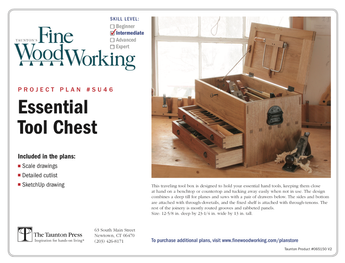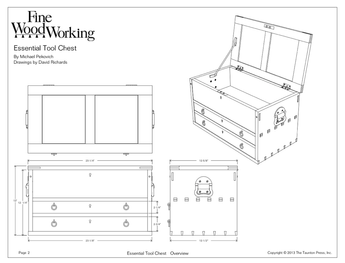Hi all
I have some beech , instead of maple , with which to make a butcher block counter top . The lenghts will be 6 feet and 4.5 feet on either side of the stove , and a 3 foot piece at right angles beside the fridge,
To keep it flat when finished I understand I use threaded rod thru the centre. Is 3/8s rod heavy enough, or should I use larger rods? The finished block will be 1 1/2 to 1 3/4 inches thick.
What spacing of the tie rods is recommended?
Finishing: I have read that mineral oil never realy dries and needs to be re-applied on an ongoing basis , but that a nut oil (peanut) will dry and harden in conjunction with some bees wax, then polished with bees wax is a preferable treatment.
I have seen a counter finished with varathane that has stood up quite well, as the cook uses cutting boards, not the counter top for
her knife work.
“Always a new way to screw up”
Stewie
The Sawdust Shop















Replies
Do a search for wooden countertops. Lots of posts about the subject. My own take is that if you want a nice, shiny countertop, get stone or solid surface. If you want a "rustic", servicable countertop, wood finished with only a food-safe oil is great. Keep it away from the stove and sink. High heat will overly dry and split/warp the wood, hot pans will burn it, water will foster mildew, rot and other grunge. (Others will say you can seal it with epoxy and it'll be fine near the sink, but to my eye, that looks like a cheap plastic countertop. Why not just install a cheap plastic countertop if that's the look you want?). You don't need threaded rods -- they woudnt keep an improperly constructed slab level anyway. Make it thick and a little surface moisture once in a while won't affect it. Go ahead and cut on it, pound on it, knead dough on it, prepare food on it, etc. Just clean it up when you're done. It'll look like a real, old-fashioned wooden kitchen countertop after a few months and you won't have to worry about adding another ding or two. (Just more character). Re- oil every six months or so. I have granite in my own kitchen around the sink & stove & a cherry countertop on the other side of the room. Both serve their functions perfectly and look good to boot. The cherry counter is about 10' long, built up from 2"X2" stock, joined with poly and biscuits (just to help keep it straight during glue-up) and has been in service for about 8 years now. Just keeps looking better and better with hard daily use.
Mike Hennessy
Pittsburgh, PA
Stewie,
As for rebar, I wouldn't use it!
wood shrinks and expands depending on moisture, steel doesn't! it's an inherant conflict.
Do glue ups. they just had a piece on glues and I won't rehash that here but select your glue and only assemble what you can control.. don't try to do the whole thing at one shot or you'll have a mess.
I made my own curved butcher block walkway (go to breaktime at 85891.22 for pictures) and I wish I'd had more time to spend doing the glue up,, more time spent aligning things prior to final clamping would have dramatically cut down on the time I spent planning and sanding the surface flat.
Edited 7/19/2007 7:58 am ET by frenchy
Thanks, Frenchy. I am gluing up 4" widths each time , then putting 3 4" sections together to get a 12" 1/2 I can run thru the planer. The first section is 5'8" long. When I went to glue up a 4" section, the boards showed up with a 3/32nd gap in the middle. Should I cut the "wow" out of it, or just clamp it closed?? If titebond 111 is left in clamps to dry overnight, will the glue hold it closed long term??Stewie
"Always a new way to screw up"
stewie.
If the wood is slightly less than perfect then you must make the clamps take up the slack or as you noted you'll have gaps.. I use bar clamps over those quick grip clamps because I can get much much more pressure with bar clamps than quick grips.
You can't fill gaps in butcher block and have it come out looking right.
While having the joint "sprung" a bit is a good thing, I'd think that 3/32nd is a bit much to want to pull out with the clamps. That will leave a lot of tension in that joint. Eliminating it, or most of it, would be a good idea, in my opinion.
You don't need threaed rod. It will actaully cause more problems than solve.
According to the shrinkage calculator a 24" American Beech flat sawn top at 8 % is going to 10 % will expand 7/32". Better just make sure all the boards are of the same moisture content.
Hey Stewie, like Mike said, you don't need any rods in a countertop. This old technology was used for commercial work tops when glues holding power was not up to todays performance. They don't keep it flat, just together. You do need good woodworking skills to get your individual pieces straight and flat as well as keeping the assembly flat during glue up. I like beech, it's usually quite stable and durable. Selecting your stock and paying attention to end grain orientation is important. Wood counters are either face grain, edge grain or end grain. Edge grain is the most stable.
Mineral oil actually evaporates and rather quickly. Nut oils and other food oils may cause severe problems for anyone with nut allergies. They can also go rancid and promote growth of nasty organisms. There are finishes specifically formulated for countertops, Behlen's salad bowl finish is one. In commercial kitchens, counters are washed down regularly with bleach water, a mild solution of bleach and water. This eliminates microbial growth. Most finishes will be adversely effected by the bleach but it's a good way to keep the kitchen safe. Mineral oil can be applied as often as you want. Many just leave the top bare and learn that wood tops will eventually show a good deal of "character".
Some commercial manufacturers use a tung oil based finish, such as Waterlox or Satin oil. These may not be compatible over an oil such as mineral or linseed. They won't stand up to bleach either. These finishes are a good choice and should be applied on all sides. Clean up can be done with vinegar and water or a mild soap and water. A paste furniture wax can be applied to this type of finish and will aid in appearance and clean up.
Solid wood is going to move. You need to account for this in your structure and attachment. Heat and moisture are enemies. Extra insulation over the dishwasher is often used. With a finished counter, you need to avoid cutting or placing hot or messy items on it. The finish is quite easy to repair or re-cote when needed.
In the old days, we used to melt paraffin in mineral oil and slather it on. This helped protect the natural tops from absorbing moisture while in the shop, during transit and for a limited time, in use. Today, some shops are using 2K urethanes or moisture cure urethanes. These are not generally available to the public and require NIOSH training and a bit of experience. For a home, I think the tung oil finishes are the way to go, whether they contain tung oil or not. You just have to treat the tops with some extra care to maintain the appearance.
Beat it to fit / Paint it to match
Per Hammer1: "Solid wood is going to move. You need to account for this in your structure and attachment."
IMHO, the best attachment for a butcher block top is no attachment. If it's of any size, it'll be heavy enough that it won't go anywhere you don't want it to go. For smaller tops, a dab or two of silicone along the back edge will work.
Mike Hennessy
Pittsburgh, PA
Strong enough ? 3/8 allthread is going to have an average tensile strength of about 73,000 lbs. depending on the mfg. process(hot rolled/cold rolled&carbon content)
Work Safe, Count to 10 when your done for the day !!
Bruce S.
BruceS
you're thinking the wrong way.. the problem is if you make it tight when it's dry and it swells due to moisture the threaded rod won't do anything except crush wood fibers. the wood will still swell.. that's the true nature of wood.. when you attempt to stop wood from moving you will fail (unless you can perfectly control the climate 100%)
The finish I like to use on things like cutting boards and salad bowls is straight paraffin applied with heat. This makes a safe waterproof finish that can be renewed if/when it is needed. For heat on a flat surface I use an iron on a low heat setting, on curved surfaces a hair dryer blower. The same finish can be used on children's wooden toys.
This makes a safe waterproof finish
Unless you're insinuating that the heat treatment changes the characteristics of the way, a wax finish is not waterproof. It's actually the closest of all finishes to bare wood.
Also, "food-safe" finishes are not necessary. ALL commercially available finishes are food-safe once they have cured (at least 30 days).
>> ALL commercially available finishes are food-safe once they have cured (at least 30 days).Technically, all house exterior and any finish intended for use inside are required to be non-toxic, not "food safe". As far as I know, the FDA has not certified any finish as "food safe".Howie.........
As far as I know, the FDA has not certified any finish as "food safe".
This includes the finishes that say "food safe" on the label. This is just a marketing ploy, seems to work too.
I must be missing something here.
About 30 years ago, when my father was a meatcutter and owner of a small town grocery store, he gave me two maple blocks cut from a log that are about 18" x 24" planesawn and almost 2" thick.
He told me to use one for meat and the other for veggies. I carved an "M" in one and a "V" in the other. Each time after you cut on them, scrub them with a Chore Girl pad with hot, and I mean HOT water and let them dry, but not in the sun. Every ounce in a while mix some vinegar 1/2 'n 1/2 into the rinse.
I've been using them ever since and have had no problems at all. Over the 30+ years they've developed a rich patina and I'm still alive! Why in the world would you want to cut meat/veggies on your countertop?
Of course my countertops aren't made from wood, but then again why would you want them to be? Moisture and exposed wood countertops never made much sense to me anyway Isn't that why chopping blocks are made?
Just my opinion,
Bob @ Kidderville Acres
A Woodworkers mind should be the sharpest tool in the shop!
Edited 8/22/2007 9:49 pm ET by KiddervilleAcres
Edited 8/22/2007 9:50 pm ET by KiddervilleAcres
Stewie,
I started making and using butcherblock counter tops for over thirty years now in both houses I've built for others as well as myself.Having lived with bb all that time I have tried just about every fininish you can imagine. Most oils are a pita to maintain. Mineral oil tends to become gummy and really needs to be sanded to bare wood and reapplied every 6 to 12 months. If you really want an oil finish go for tung oil - apply at least 4 coats and allow it to dry completely between coats. My current countertops - maple bb 6 years old - have Minwax wipe on poly. I put on 12 coats and wiped off excess after about 30 minutes. This finish has been tottaly maintainence free and is the best looking I have ever used.
Steve
This forum post is now archived. Commenting has been disabled